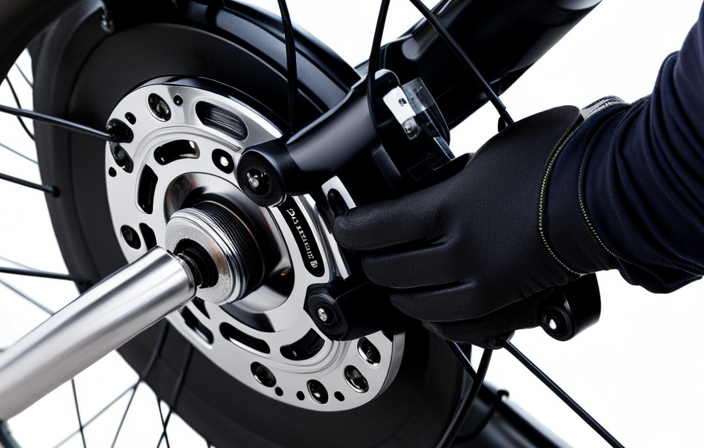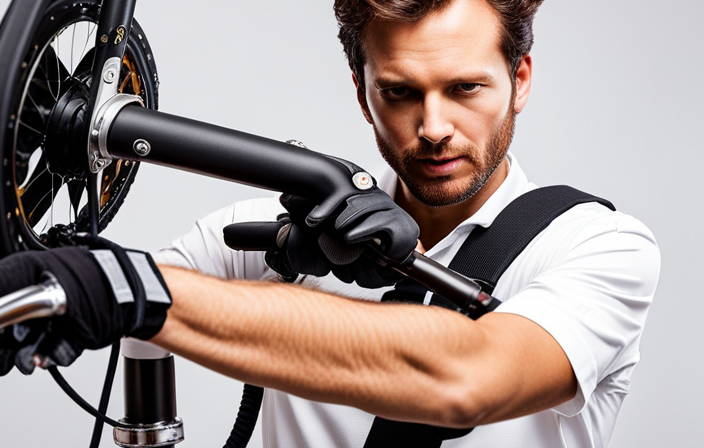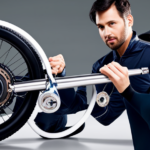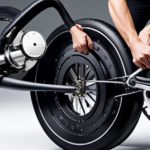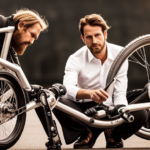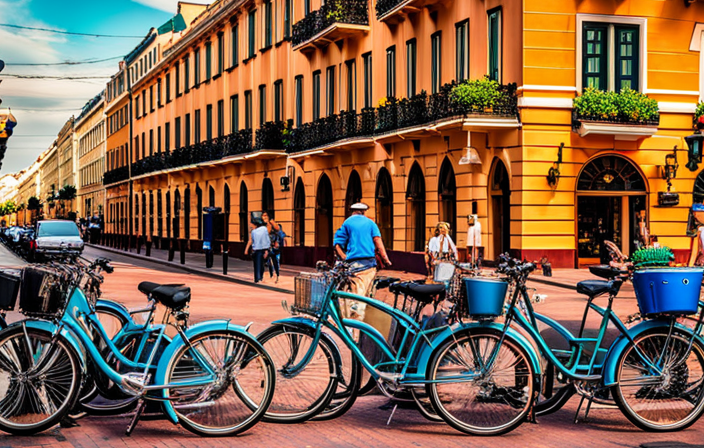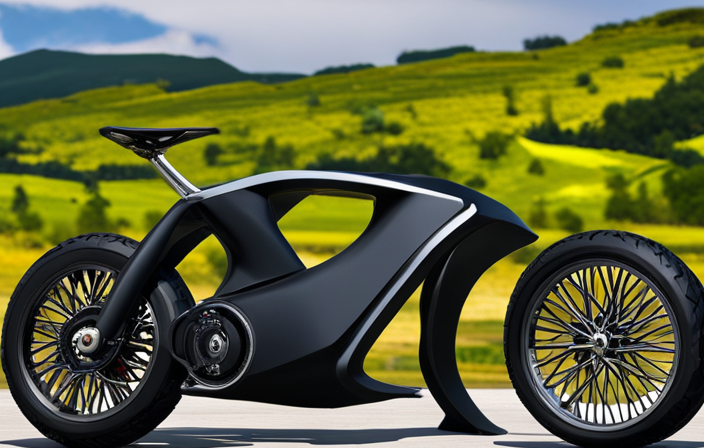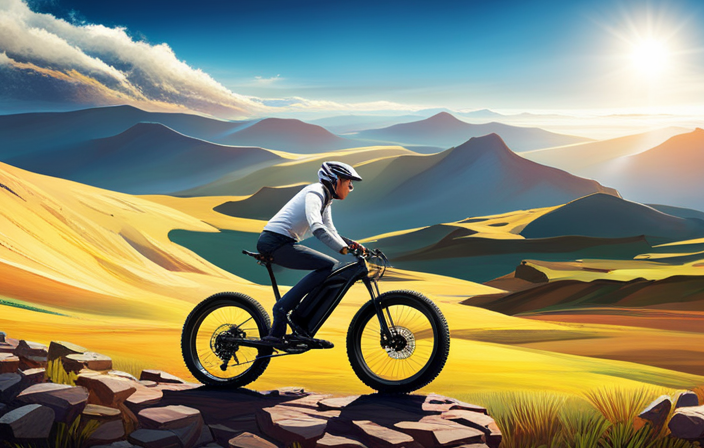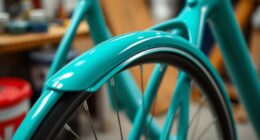They say that knowledge is power, and when it comes to maintaining your Colombia electric bike, this adage couldn’t be more true.
One crucial aspect of your bike’s performance is the hub motor, which is responsible for propelling you forward. Understanding how to open and troubleshoot the hub motor can save you time and money on repairs.
In this article, I will guide you through the step-by-step process of opening the hub motor, providing you with the technical know-how and precise instructions you need to keep your bike running smoothly.
Key Takeaways
- Disconnect the battery before opening the hub motor to avoid electrical hazards
- Carefully remove the outer casing using appropriate tools to access the motor components
- Inspect the motor components for any damage or wear
- Follow the manufacturer’s guidelines for reassembling the motor after troubleshooting or repairing any issues
Introduction to Hub Motors in Electric Bikes
Hub motors are a key component in electric bikes. They offer several advantages and disadvantages compared to other types of motors.
One advantage is their simplicity, as they eliminate the need for a chain or belt drive system. This makes them more reliable and requires less maintenance.
However, hub motors tend to be heavier than other types of motors, which can affect the overall weight and balance of the bike.
There are different types of hub motors, including geared hub motors and direct drive hub motors. Geared hub motors are smaller and lighter, making them suitable for urban commuting.
On the other hand, direct drive hub motors are larger and more powerful, making them ideal for off-road or long-distance riding.
Understanding the different types of hub motors and their applications is crucial for choosing the right motor for your Colombia electric bike. This will ensure optimal performance and a smooth riding experience.
Importance of Hub Motor in Your Colombia Electric Bike
The hub motor plays a crucial role in enhancing your riding experience on your Colombia e-bike. Here are the reasons why the hub motor is of utmost importance:
-
Increased Efficiency: The hub motor’s direct power transmission ensures minimal energy loss, resulting in improved overall efficiency.
-
Smooth Riding Experience: With the hub motor’s seamless integration into the wheel, you can enjoy a smooth and quiet ride without any noticeable vibrations or noise.
-
Low Maintenance: Hub motors require minimal maintenance compared to other types of electric bike motors. This means less time spent on upkeep and more time enjoying your ride.
-
Simplified Design: The hub motor’s compact and integrated design allows for a streamlined appearance, making it aesthetically pleasing while still delivering powerful performance.
Understanding the components of a hub motor is essential to ensure proper maintenance and troubleshooting.
Understanding the Components of a Hub Motor
To better understand the components of a hub motor, you should familiarize yourself with its various parts and their functions. Understanding hub motor technology is crucial for maintaining and repairing your Colombia electric bike. Here is a breakdown of the key components of a hub motor:
| Component | Function |
|---|---|
| Stator | Creates a magnetic field that interacts with the rotor to produce motion. |
| Rotor | Consists of permanent magnets that rotate when a current is applied, creating the driving force. |
| Hall Sensors | Detect the rotor’s position and send signals to the controller for precise control. |
| Controller | Regulates the flow of electricity to the motor, controlling speed and torque. |
| Bearings | Reduce friction and allow smooth rotation of the motor. |
By understanding these components and their functions, you can better diagnose and troubleshoot any issues with your hub motor. Additionally, proper maintenance tips for hub motors can help prolong their lifespan and ensure optimal performance. With this knowledge, let’s move on to discussing the tools and equipment needed to open the hub motor and perform necessary repairs.
Tools and Equipment Needed to Open the Hub Motor
You’ll need a set of specific tools and equipment in order to access and perform necessary repairs on your Colombia electric bike’s hub motor. The tools needed include a set of Allen wrenches, a screwdriver set with various heads, a torque wrench, a set of pliers, and a rubber mallet. These tools will allow you to remove the outer casing and access the inner components of the hub motor.
Before starting, make sure to gather all the necessary tools and ensure they are in good condition.
In the next section, I will provide a step-by-step guide to opening the hub motor, which will allow you to inspect and repair any issues that may arise.
Step-by-Step Guide to Opening the Hub Motor
To open the hub motor on my Colombia electric bike, I’ll need to follow a step-by-step guide.
The first step is to remove the wheel from the bike. This involves loosening the bolts and carefully lifting the wheel off the frame.
Next, I’ll detach the motor casing. This can be done by unscrewing the bolts and gently prying it open.
Once the casing is removed, I’ll disconnect the wiring. This can be done by carefully unplugging the connectors.
This will give me access to the magnets and stator inside the hub motor.
Removing the wheel
First, make sure you have the necessary tools to remove the wheel. You’ll need a wrench, preferably an adjustable one, to loosen the nuts or bolts securing the wheel in place. Once you have the tools ready, follow these steps to remove the wheel:
- Start by flipping the bike upside down or placing it on a sturdy bike stand to access the wheel easily.
- Use the wrench to loosen the nuts or bolts holding the wheel in place. Make sure to loosen them enough to remove the wheel but not completely.
- Lift the bike slightly to take the weight off the wheel, then fully remove the nuts or bolts.
- Carefully slide the wheel out of the dropouts, taking note of any washers or spacers that may be present.
With the wheel removed, we can now move on to detaching the motor casing.
Detaching the motor casing
Now, it’s time to remove the casing that houses the motor. This step is crucial in gaining access to the internal components of the hub motor.
To begin, locate the screws or bolts securing the casing to the bike frame. Using a suitable tool, carefully remove these fasteners. Once the casing is loose, gently pull it away from the motor, taking care not to damage any wiring or other components.
With the casing removed, you will now have a clear view of the internal workings of the motor. Take this opportunity to inspect the components for any signs of damage or wear. This will help you determine if any repairs or replacements are necessary.
Next, we will move on to disconnecting the wiring, ensuring a safe and thorough inspection of all the motor’s elements.
Disconnecting the wiring
After removing the motor casing, it’s important to disconnect the wiring to safely inspect the internal components. This step is crucial for troubleshooting common issues and ensuring the smooth operation of the electric bike.
Here are five important precautions to keep in mind while handling the wiring:
- Before disconnecting any wires, ensure that the electric bike is turned off and the battery is disconnected.
- Use a multimeter to check for any voltage present in the wires before touching them.
- Carefully trace each wire to its connection point and make a note of the wire color and position.
- Gently unplug the connectors by pulling them apart, avoiding any excessive force that could damage the wires or connectors.
- Keep the disconnected wires organized and away from any moving parts or sharp edges to prevent any damage.
Once the wiring is safely disconnected, we can proceed to the next step of accessing the magnets and stator in order to further diagnose and address any potential issues.
Accessing the magnets and stator
After disconnecting the wiring, the next step in accessing the magnets and stator of the hub motor on a Colombia electric bike is crucial for maintenance or repairs.
To ensure proper functioning of the motor, it is important to pay attention to magnet alignment. Carefully removing the cover will reveal the magnets and stator assembly.
The magnets play a crucial role in generating the magnetic field that drives the motor, while the stator winding techniques determine the efficiency and power output. Inspecting the magnets for any signs of damage or misalignment is essential. Additionally, examining the stator winding for any loose or damaged wires is necessary for optimal performance.
Taking precautions and safety measures such as wearing protective gloves and eyewear is essential before proceeding to the next step.
Precautions and Safety Measures
Before beginning the process of opening the hub motor on my Colombia electric bike, I made sure to disconnect the battery to avoid any potential electrical hazards.
I handled the motor with utmost care, being mindful of its delicate components and avoiding any unnecessary force or impact.
Additionally, I wore the necessary protective gear, such as gloves and safety glasses, to protect myself from any potential injuries during the process.
Disconnecting the battery
To disconnect the battery on your Colombia electric bike, simply locate the battery compartment and unplug the connector. Here are some battery maintenance tips and troubleshooting steps to keep in mind:
-
Regularly check the battery connections for any signs of corrosion or loose fittings. Clean and tighten them if necessary to ensure a secure connection.
-
If you notice a decrease in battery performance or range, try resetting the battery management system by disconnecting and reconnecting the battery. This can help resolve minor issues.
-
In case of persistent battery problems, consult the manufacturer’s manual or reach out to customer support for guidance. They can provide specific troubleshooting steps to diagnose and fix any battery-related issues.
Now that the battery is safely disconnected, let’s move on to handling the motor with care.
Handling the motor with care
Be careful when handling the motor, making sure to avoid any potential damage or mishandling. The motor is a crucial component of the electric bike, and it needs to be handled with care.
When removing the motor, it is important to disconnect any electrical connections properly to prevent any electrical shocks. Additionally, ensure that the motor is stored in a proper location to avoid any water damage. Moisture can cause corrosion and damage the internal components of the motor. It is recommended to store the motor in a dry and secure place.
Next, we will discuss the importance of using protective gear when working with the motor.
Using protective gear
Ensure you’re wearing protective gear when working with the motor to ensure your safety. Using safety equipment is crucial to protect yourself from potential hazards. Here are some proper handling techniques to follow:
- Wear a helmet: Protect your head from any potential impact or falls.
- Use safety goggles: Prevent debris or particles from entering your eyes.
- Wear gloves: Provide a barrier between your hands and any sharp edges or hot surfaces.
By using these safety measures, you minimize the risk of injuries while working with the motor.
Next, we will discuss troubleshooting common issues with hub motors. It is important to be prepared for any potential problems that may arise during the maintenance or repair process.
Troubleshooting Common Issues with Hub Motors
If you’re experiencing issues with your hub motor, troubleshooting common problems can help identify the cause. Here are some maintenance tips for hub motors to help you troubleshoot common issues:
| Problem | Possible Cause | Solution |
|---|---|---|
| No power | Loose connections | Check and tighten all connections |
| Grinding noise | Misalignment of gears | Realign gears or replace damaged ones |
| Overheating | Excessive load or poor ventilation | Reduce load or improve ventilation |
These tips can help you diagnose and fix common issues with your hub motor. However, if the problem persists, it may be necessary to consider repairing or replacing hub motor components. By following these troubleshooting steps, you can identify the cause of the problem and take appropriate action to ensure the optimal performance of your electric bike.
Repairing or Replacing Hub Motor Components
Now that we have identified and troubleshooted common issues with hub motors, it’s time to dive into repairing or replacing the faulty components.
When it comes to repairing the hub motor, it’s crucial to have a good understanding of its internal structure. Begin by carefully removing the outer casing of the motor using the appropriate tools.
Once the casing is removed, inspect the motor components for any signs of damage or wear. If any components are found to be faulty, such as the stator or the magnets, they will need to be replaced. Make sure to source high-quality replacement parts that are compatible with your specific hub motor model.
With the new components in hand, follow the manufacturer’s guidelines to reassemble the hub motor and ensure everything is back in place for optimal performance.
Reassembling the Hub Motor
Once the casing is removed, I carefully inspect the motor components for any signs of damage or wear. It is crucial to ensure that all the parts are in good condition before proceeding with the reassembling process.
To begin reassembling the hub motor, I start by placing the rotor back onto the stator, making sure the alignment is correct. Then, I secure it with the necessary bolts, ensuring they are tightened properly.
Next, I carefully reconnect the wires, making sure they are securely attached and properly insulated. Once all the components are back in place, I test the motor to ensure it is functioning correctly. If any issues arise, I use troubleshooting methods to identify and resolve them.
With the reassembling techniques and troubleshooting methods, I can confidently conclude that the hub motor is ready to be used again.
Moving on to the next section, I will provide some final tips for maintaining the hub motor.
Conclusion and Final Tips for Maintaining Your Hub Motor
To properly maintain your hub motor, remember to regularly inspect the components for any signs of damage or wear. This will ensure that your electric bike continues to perform at its best and prolong the lifespan of your hub motor. Here are some final tips for maintaining your hub motor:
- Keep the hub motor clean and free from debris by regularly wiping it down with a damp cloth.
- Check the tightness of the motor axle bolts and torque them to the manufacturer’s specifications if necessary.
- Lubricate the internal gears of the hub motor with a high-quality lubricant to reduce friction and ensure smooth operation.
- Inspect the wiring connections and make sure they are secure and free from any damage or corrosion.
- Monitor the temperature of the hub motor during operation and avoid excessive heat buildup, as this can damage the motor.
By following these tips and regularly maintaining your hub motor, you can ensure that your electric bike remains in optimal condition and enjoy a longer lifespan for your hub motor.
Frequently Asked Questions
How much does it typically cost to repair or replace hub motor components?
The cost of hub motor repair can vary depending on the specific components that need to be replaced. However, replacing hub motor components can improve the performance and longevity of the motor, ensuring optimal functioning of the electric bike.
Can I open the hub motor on my electric bike without any prior mechanical knowledge or experience?
Opening the hub motor on an electric bike without prior mechanical knowledge or experience can be challenging. It is crucial to troubleshoot the motor first and consult a professional for assistance to avoid causing further damage.
Are there any specific tools or equipment that are recommended for opening the hub motor?
To open the hub motor, specific tools and recommended equipment are necessary. These tools may include a wrench, screwdriver, and specialized hub motor removal tool. It is important to have the right equipment to ensure a successful disassembly process.
What are some common issues that could occur with hub motors and how can they be fixed?
Common issues with hub motors include overheating, loss of power, and noise. To troubleshoot, check for loose connections, clean the motor, and ensure proper ventilation. If problems persist, consult a professional for further diagnosis and repair.
How often should I open and maintain the hub motor on my Colombia electric bike?
To properly clean and lubricate the hub motor on a Colombia electric bike, it is recommended to do so every 500-700 miles. Signs indicating the need for maintenance include excessive noise, decreased performance, and resistance while pedaling.
Conclusion
In conclusion, maintaining and repairing the hub motor in your Colombia electric bike is essential for optimal performance.
Just like a well-oiled machine, a properly functioning hub motor is the heart of your bike, propelling you forward with ease and efficiency.
Neglecting its maintenance can lead to issues that may leave you stranded on the road.
By following the step-by-step guide and troubleshooting common issues, you can ensure the longevity of your hub motor.
Remember, a well-maintained hub motor is the key to a smooth and enjoyable ride.
